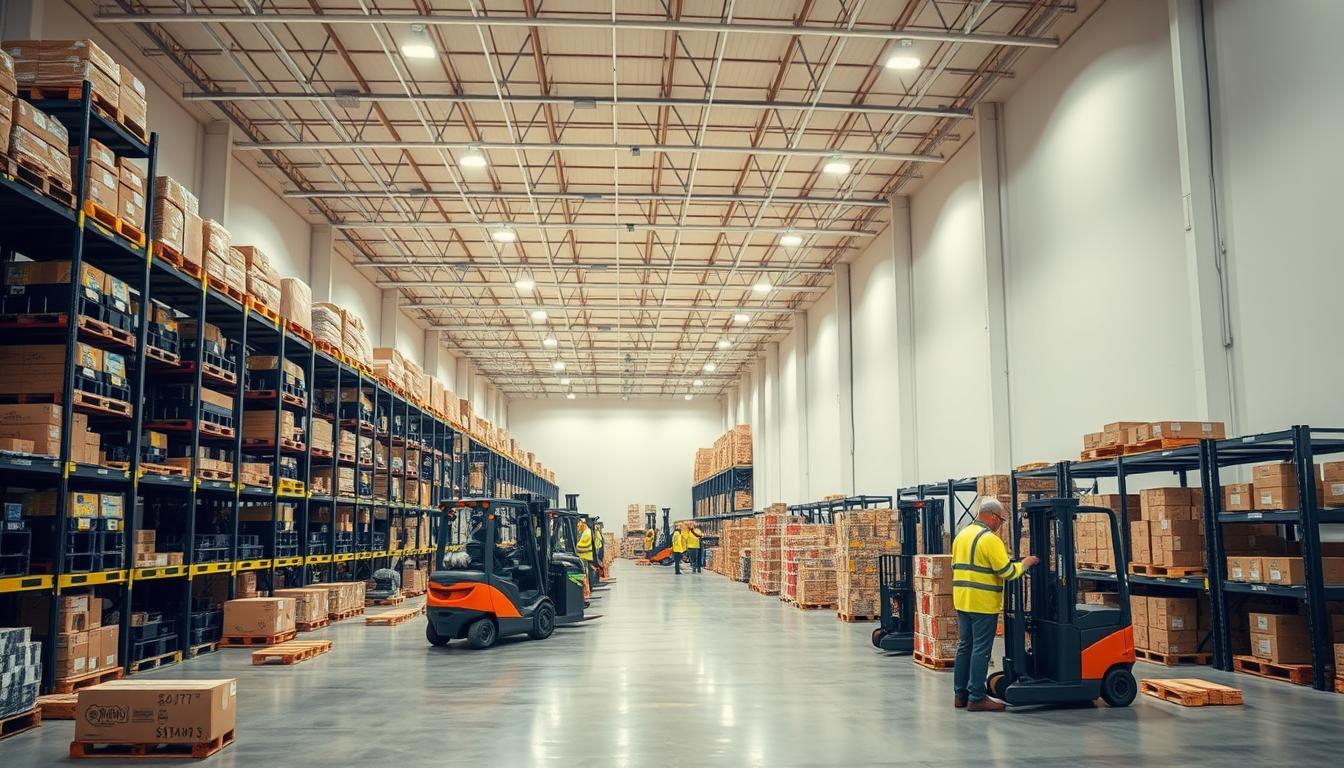Efficient Warehousing and Distribution Services
In the United States, the efficiency of operations heavily relies on the synchronization of storage and flow. This piece delves into how warehousing and distribution act as key drivers. They enhance service quality and reduce costs. It clarifies definitions, outlines service areas, and discusses how facility types and technology contribute to a superior distribution network.
Deloitte’s data reveals that 59% of companies outsource to cut costs. Statista’s Martin Placek reports that 63.5% of shippers turned to 3PLs for warehousing in July 2021. These statistics underscore a trend towards specialized partners. They combine data-driven strategies with secure, compliant facilities. For U.S. leaders, the aim is to choose warehousing solutions that meet storage needs with swift, reliable delivery.
In Toronto, providers like custom Warehouse Management Systems for real-time data and secure hubs are common. These methods are applicable in the U.S. market. Companies like RGX Group showcase advanced security, climate control, and flexible contracts. These are key for logistics and distribution in major U.S. areas. The objective is a robust network that grows, meets deadlines, and fosters growth.
The following sections will define warehousing and distribution, discuss 3PL services, and detail facility types. They will also explore the role of WMS in improving accuracy. The discussion will cover outsourcing decisions and designing a U.S. location strategy. Each topic is linked to performance, aiming for quicker cycle times, lower costs, and a more intelligent distribution network.
What Are Efficient Warehousing and Distribution Services in Modern Supply Chains
Efficient operations ensure goods move on time and at the right cost. In the United States, leading brands use warehousing and distribution to balance capacity, speed, and accuracy. The goal is to shorten order cycles while protecting inventory value across supply chain management.
Defining warehousing versus distribution
Warehousing focuses on storing inventory for longer periods, maintaining strict control over condition, count, and compliance. Distribution, on the other hand, emphasizes predictable movement—receiving, processing, and shipping goods to the next node or the end customer.
Both share core activities such as put-away, inventory handling, and processing. Warehousing aims for stability and preservation, while distribution targets steady throughput, fast picks, and accurate order fulfillment within logistics and distribution networks.
How 3PL providers bridge storage and last-mile logistics
Third-party logistics providers integrate storage with downstream tasks to close execution gaps. They offer long- and short-term storage, temperature-specific zones, co-packing and assembly, rework and sorting, reverse logistics, quality checks, container de-stuffing, custom packing, and product labeling.
Advanced operators use a warehouse management system that synchronizes warehousing and distribution with carrier pickups and last-mile steps. Real-time visibility supports consolidation, de-consolidation, cross-docking, and rapid packaging, creating a single flow from inbound receipt to doorstep delivery within logistics and distribution.
Core functions within supply chain management
These services position inventory close to demand and sharpen order cycle time. Distribution centers execute cross-docking, mixing, light manufacturing, packaging, and order fulfillment to maintain continuity across supply chain management.
The result is disciplined execution of OTIF targets and a lower cost-to-serve. From raw material stockpiles to rapid-turn consumer goods, aligned warehousing and distribution practices keep products available, compliant, and ready for movement through U.S. markets.
Key Differences Between Storage-Centric Warehousing and Flow-Focused Distribution
Storage-centric facilities store goods for extended periods, while flow-focused nodes expedite goods with minimal delay. This distinction significantly influences inventory management, order fulfillment, and the scheduling and costing of transportation and warehousing.
Long-term inventory storage vs. predictable product flow
Storage-centric warehousing prioritizes capacity and cost-effectiveness, often holding industrial inputs and raw materials in reserve. This strategy aims to mitigate price volatility and supply chain risks. It relies on consistent handling and periodic inventory checks.
On the other hand, flow-focused distribution emphasizes swift product movement. It caters to fast-moving consumer goods and fresh produce, ensuring they move through the system efficiently. This approach requires precise labor planning and dock scheduling to maintain a smooth flow and avoid delays.
Impacts on lead times, OTIF, and customer expectations
Storage-centric strategies can extend planning horizons, improving resilience. Centralized stock pools help manage demand spikes, ensuring on-time delivery. Inventory management is guided by safety stock placement and ABC analysis.
Flow-focused distribution, by contrast, aims to reduce order cycle times. It optimizes dock operations, carrier appointments, and yard movements. This approach aligns with customer expectations for timely delivery, making order fulfillment a critical service metric.
Use cases: raw materials stockpiling vs. rapid-turn products
Manufacturers stockpile materials like steel and resin to stabilize production costs. These goods benefit from deep racking, controlled environments, and regular quality assessments. Inventory management focuses on tracking aging, lot control, and reordering based on forecast variations.
Rapid-turn items, such as produce and eCommerce parcels, are processed through high-velocity systems. Retailers and brands selling directly online require synchronized order fulfillment and reliable logistics to maintain freshness and speed. Strategic locations and WMS-driven tasks are essential for both models, ensuring accuracy without compromise.
Typical 3PL Services That Drive Logistics and Distribution Performance
Third-party logistics providers enhance operational capacity with specialized services. These services boost throughput and order accuracy. They manage inventory, transportation, and flexible warehousing solutions, aligning with national demand patterns in the United States. This results in tighter process control and flexibility during seasonal peaks.
Value-added services: co-packing, assembly, labeling, and rework
Leading 3PLs offer co-packing, kitting, light assembly, and product labeling to expedite market readiness. They also handle rework and sorting to correct packaging errors and meet retailer standards. These services, performed alongside storage, reduce lead times and support precise launch dates and promotions.
Providers manage order consolidation, de-consolidation, and custom packing. By aligning these tasks with slotting plans and pick paths, third-party logistics reduces touches and improves pick rates. This strengthens logistics and distribution performance at scale.
Reverse logistics, quality checks, and container de-stuffing
Reverse logistics includes returns processing, refurbishment, and disposition rules to protect margin and brand standards. 3PL teams execute quality checks at inbound and outbound to prevent defects. At ports and inland hubs, container de-stuffing, short-term staging, and cargo sorting accelerate flow from vessel to final node.
These procedures enable traceable inventory movements and rapid exception handling. Integrated workflows connect receiving, inspection, and putaway. This maintains service levels even when volumes spike.
How third-party logistics reduces cost-to-serve
Outsourcing avoids capital expense for buildings, automation, and lift equipment. It leverages shared labor and WMS sophistication. Deloitte reports most firms outsource to save money, and Statista noted broad shipper adoption of 3PL warehousing in 2021. Scale economics, engineered labor standards, and network density drive lower unit costs.
Third-party logistics providers position facilities near interstates, rail ramps, and parcel hubs. This shortens transport legs and cuts handling. With real-time visibility and flexible capacity, logistics and distribution networks process more orders per hour. This reduces dwell, lowering total cost-to-serve across SKUs and channels.
Types of Warehouses and Functional Roles Across the Distribution Network
Facility design and controls are key to efficient goods movement in a distribution network. Warehousing and distribution must align with product risk, temperature needs, and throughput targets. This ensures efficient transportation and warehousing across regions.
Operators like RGX Group and PPFD use climate controls, WMS, and security to match storage formats with product attributes and order profiles. This approach leads to tighter governance, faster turns, and consistent service across national lanes.
Ambient, temperature-controlled, cold storage, and freezer spaces
Ambient buildings handle durable goods with stable shelf life. Temperature-controlled zones protect sensitive items like cosmetics and electronics. Cold storage supports perishables, while freezer spaces meet sub-zero requirements for frozen foods and ice cream.
Pharmaceuticals often combine climate control with contamination-safe areas. Industrial and light‑industrial sites add staging for kitting and light assembly. This improves warehousing and distribution without sacrificing quality controls.
Distribution centers, fulfillment centers, bonded and contract facilities
Distribution centers focus on high-throughput pallet and case flow, supporting cross-regional replenishment. Fulfillment centers emphasize order processing, pick and pack, and cartonization for direct-to-consumer demand.
Bonded warehouses keep imports under customs control until duties are cleared. Contract facilities provide fixed capacity, SLAs, and shared systems. Private and public sites offer different ownership and cost models within transportation and warehousing networks.
Cross-docking, hazmat, and reverse logistics warehouses
Cross-docking locations move freight from inbound to outbound with minimal dwell, cutting handling and lead time. Hazmat warehouses add regulated storage, fire protection, and segregation for chemicals and batteries.
Reverse logistics warehouses process returns, grading, and refurbishment to recover value. Government and cooperative sites support community needs and surge capacity, strengthening resilience across the distribution network.
| Warehouse Type | Primary Role | Typical Goods | Key Controls | Impact on Transportation and Warehousing |
|---|---|---|---|---|
| Ambient | General storage and replenishment | Durables, paper, hardware | Racking, inventory zoning | Balanced costs and cycle times across the distribution network |
| Temperature-Controlled | Quality preservation at set ranges | Electronics, cosmetics, pharma | HVAC, humidity controls, monitoring | Reduced spoilage; stable service in warehousing and distribution |
| Cold Storage | Chilled handling and staging | Produce, dairy, beverages | Refrigeration, rapid throughput | Tighter dwell windows; efficient transportation and warehousing links |
| Freezer | Sub-zero compliance | Frozen foods, ice cream | -10°F to -20°F zones, PPE | Strict temperature chain across the distribution network |
| Distribution Center | Pallet/case flow and replenishment | Retail and wholesale SKUs | Conveyance, WMS-directed moves | Higher throughput for warehousing and distribution |
| Fulfillment Center | Order processing and shipping | DTC and eCommerce items | Pick and pack, cartonization, WMS | Faster last-mile within transportation and warehousing |
| Bonded | Customs-controlled storage | Imported goods pending duties | Customs seals, audit trails | Deferred taxes; flexible global distribution network flows |
| Contract | Dedicated capacity with SLAs | Program-based portfolios | KPIs, shared labor plans | Predictable costs in warehousing and distribution |
| Cross-Dock | Rapid transload and sort | Time-sensitive freight | Door scheduling, scan-based routing | Lower handling; shorter lead times |
| Hazmat | Regulated materials storage | Chemicals, lithium batteries | NFPA compliance, containment | Risk control across transportation and warehousing |
| Reverse Logistics | Returns, grading, refurbishment | Consumer goods, electronics | Inspection stations, quarantine | Value recovery within the distribution network |
Warehousing and Distribution
Integrated operations transform inventory into service. Warehousing and distribution connect storage buffers with channel reach. They align safety stock, processing, and fast order release within supply chain management. Modern facilities use WMS-directed slots, cycle counts, and risk controls to stabilize flow.
Outbound teams execute consolidation, de-consolidation, and pick and pack to hit OTIF targets. This ensures efficient distribution.
In Canada’s largest freight corridor, PPFD operates Toronto hubs with a custom WMS and real-time analytics. These guide labor, dock scheduling, and parcel cutoffs. Warehousing solutions include secure handling and scalable pick paths that match short order cycles.
RGX Group runs sites in Toronto, Mississauga, and Brampton with advanced security, climate control, and inventory tracking. Contracts scale from seasonal peaks to year-round programs. This pairs value-added services with precise inventory positioning.
This model keeps fast-moving goods close to carriers and intermodal links. It supports cost-efficient throughput across distribution lanes.
Together, these practices span storage, processing, and outbound flow. The result is synchronized warehousing and distribution. It supports demand volatility, reduces touches, and protects margin in supply chain management.
It leverages adaptable warehousing solutions for diverse product profiles.
| Capability | Operational Focus | Measured Outcome | Illustrative Provider Practice |
|---|---|---|---|
| Storage Buffering | Safety stock, slotting, climate control | Lower stockouts, stable lead times | RGX Group climate-managed aisles with audited cycle counts |
| Processing & Value-Add | Co-packing, labeling, kitting, rework | Fewer touches, faster release | PPFD pick and pack integrated with a custom WMS |
| Flow Consolidation | Consolidation/de-consolidation, cross-dock | Improved trailer fill, reduced dwell | RGX Group dock scheduling aligned to carrier cutoffs |
| Visibility & Control | Real-time analytics, inventory accuracy | Higher OTIF, fewer chargebacks | PPFD dashboards for labor planning and order waves |
| Scalability | Flexible contracts, modular capacity | Peak readiness, cost control | RGX Group tiered space and labor for seasonal volume |
Technology That Powers Efficient Transportation and Warehousing Operations
Digital platforms are now the backbone of transportation and warehousing efficiency. A strong warehouse management system integrates storage, labor, and carrier movements into a single data stream. This setup offers real-time task and stock monitoring, reducing manual interactions and speeding up processes. It enhances the accuracy of order fulfillment significantly.

Warehouse management system integrations and real-time visibility
PPFD’s Toronto operations utilize a custom warehouse management system. It’s integrated with client ERPs for instant analytics and task management. This setup allows teams to monitor inbound, putaway, and pick status in real-time. It streamlines dock scheduling and yard turns.
RGX Group employs advanced inventory tools, access controls, and climate-controlled storage. These measures ensure compliance and precision in processing.
Data access for inventory management and order fulfillment accuracy
Centralized inventory views provide real-time data on quantities and locations. This enables quick updates and efficient handling of exceptions. Such data-driven capabilities lead to higher on-time in full (OTIF) rates and faster issue resolution.
As a result, order fulfillment becomes more accurate. There are fewer re-picks and smoother carrier handoffs.
Scalability and systems alignment with eCommerce channels
Direct-to-consumer models require flexible processing for flash sales and seasonal peaks. WMS-enabled workflows for cross-docking, pick and pack, and packaging scale to meet omnichannel demands without adding complexity. PPFD’s nationwide distribution and RGX Group’s 3PL fulfillment demonstrate how aligned systems keep operations synchronized. This ensures fast and consistent order fulfillment.
When and Why to Outsource to Third-Party Logistics Providers
Companies opt for third-party logistics when they need to scale, speed up, and maintain control. Outsourcing aligns costs with demand, improving warehousing and distribution across the network.
Adopting this approach shows a mature logistics and distribution strategy. It focuses on reliable service, technology access, and financial discipline.
Cost savings drivers and Deloitte-cited outsourcing trends
Deloitte found that 59% of businesses outsource to cut costs. They avoid hiring, training, and overtime expenses. They also delay capital spending on software, conveyors, forklifts, and facilities.
Third-party logistics changes fixed costs to variable rates based on throughput. This shift helps manage budgets during demand changes and peak seasons.
- Lower capital expenditure via shared infrastructure and WMS licenses
- Labor flexibility through engineered staffing and cross-trained teams
- Network optimization that reduces empty miles in logistics and distribution
Statista insight: shippers outsourcing warehousing to 3PLs
Statista, reported by Martin Placek on September 28, 2022, shows 63.5% of shippers use 3PLs for warehousing in July 2021. This indicates widespread adoption among logistics leaders in consumer goods, retail, and industrials.
This high adoption rate shows trust in providers’ ability to manage inventory, slotting, and fulfillment. They maintain service standards in warehousing and distribution.
Expertise, speed, and improved service levels
Experts like The Brimich Group, PPFD, and RGX Group highlight the benefits. They offer advanced WMS, pick and pack skills, secure operations, and locations near major routes. This leads to faster cycle times.
Centralized visibility and precise inventory control enhance OTIF and reduce costs. These capabilities boost logistics and distribution agility. Providers use standardized SOPs, real-time data, and optimized layouts to improve service quality for third-party logistics customers.
| Decision Driver | In-House Model | Outsourced to 3PL | Operational Effect |
|---|---|---|---|
| Capital Investment | High capex for facilities, equipment, and software | Shared assets and pay-as-you-go pricing | Improves cash flow; reduces balance-sheet burden |
| Labor Flexibility | Fixed headcount and overtime exposure | Variable staffing and engineered labor standards | Stabilizes unit costs during volume swings |
| Technology Stack | Licensing and integration lead times | Pre-integrated WMS, analytics, and visibility | Faster deployment and higher inventory accuracy |
| Speed-to-Customer | Constrained by static node locations | Multi-node networks near major routes | Shorter transit times and stronger OTIF |
| Process Expertise | Limited by internal bandwidth | Domain specialists across warehousing and distribution | Lower errors and fewer touches per order |
| Risk and Resilience | Single-site disruption risk | Redundant sites and contingency playbooks | Higher continuity during demand shocks |
Designing Location Strategy and Distribution Solutions for the United States
In the U.S., strategic placement of facilities can significantly reduce costs and enhance speed. This is achieved by aligning with market demand, transit time targets, and modal access. A data-driven approach ensures optimal node density for service levels, while controlling capital and operating costs for transportation and warehousing.
Strategic facilities near major transportation routes
Facilities located near Interstate corridors, Class I rail intermodals, air cargo hubs, and deepwater ports cut down on linehaul miles. This improves reliability. Key locations like I-95, I-5, I-10, and I-80 support both coastal and transcontinental coverage. Chicago, Dallas–Fort Worth, Atlanta, and Los Angeles offer dense cross-modal options.
Access to BNSF and Union Pacific intermodals, along with air gateways like Memphis, Louisville, and Cincinnati, shortens cycle time for parcel and pallet flows. Ports like Los Angeles–Long Beach, Savannah, and New York–New Jersey expedite import throughput within a national distribution network.
Balancing hub-and-spoke with distributed networks
Hub-and-spoke designs focus inventory for scale economies, using consolidation and cross-docking to speed up flow. Distributed networks place regional nodes near demand to tighten delivery windows and enhance OTIF performance.
Distribution centers, fulfillment centers, and cross-dock sites can be combined to match product velocity. Regional warehouses hold buffer stock, while fast movers pass through flow-focused nodes. This improves efficiency without excess handling.
Aligning capacity, security, and compliance needs
Facility design must reflect product risk and regulatory requirements. Temperature-controlled zones and pharmaceutical-grade spaces safeguard sensitive goods. Bonded and hazmat-compliant facilities manage customs and safety mandates.
Capacity planning should match peak profiles and seasonality, backed by WMS integrations for auditability and SLA control across the U.S. node map. This alignment enables precise governance across the distribution network. It supports resilient supply chain management under shifting demand and regulatory change.
Conclusion
Efficient warehousing and distribution hinge on aligning storage with predictable product flow. This begins with clear facility roles and disciplined processes. It then scales with technology and expert 3PL execution. Deloitte notes that 59% of companies outsource for cost savings. Statista, as reported by Martin Placek, shows 63.5% of shippers outsourced warehousing in 2021. The benefits are evident: lean networks, lower capital exposure, and higher service reliability.
Technology acts as a force multiplier. A robust WMS enhances accuracy, speeds up pick and pack, and offers real-time control. Case-led models, like secure operations in Toronto hubs, show how integrated systems boost OTIF and inventory integrity. When designing U.S. networks, firms should locate near major interstates, ports, and rail nodes. They should also choose the right mix of distribution centers, fulfillment centers, cross-dock, bonded, hazmat, and climate-controlled facilities.
Effective warehousing solutions combine standardized procedures with value-added services. These include co-packing, labeling, rework, and reverse logistics. This approach reduces cost-to-serve while maintaining quality and compliance. With the right 3PL, companies can consolidate expertise, speed up cycle times, and enhance visibility across inbound and outbound flows.
The result is consistent order fulfillment and resilient performance. By integrating data-driven planning, WMS-enabled execution, and strategic siting, organizations can convert fixed costs into scalable capabilities. This is the practical route to modern warehousing and distribution: precise operations, measurable savings, and dependable customer service.
FAQ
How do warehousing and distribution differ in modern supply chain management?
Warehousing focuses on storing inventory for extended periods. In contrast, distribution aims for quick, efficient product flow and order fulfillment. Both involve handling inventory, but distribution emphasizes speed and reliability. This ensures inventory management meets service-level goals across the network.
What services do 3PL providers offer to connect storage with last-mile logistics and order fulfillment?
Third-party logistics providers offer a range of services. These include long- and short-term storage, pick and pack, and co-packing. They also handle assembly, rework, sorting, and product labeling. Custom packing, quality checks, consolidation, and de-consolidation are also part of their offerings. These services link inventory with transportation and warehousing for faster delivery.
Which facility types support different logistics and distribution requirements?
Various facility types cater to different logistics needs. Networks include ambient, temperature-controlled, cold storage, and freezer warehouses. Industrial and light-industrial sites are also available. Distribution centers, fulfillment centers, and bonded warehouses support different functions.
Specialized facilities like cross-docking, hazmat, and reverse logistics centers address specific needs. These include rapid transload, regulated materials, and returns processing.
How does a Warehouse Management System (WMS) improve visibility and accuracy?
A WMS centralizes inventory data, providing real-time information. It supports barcode/RFID capture, cycle counts, and lot and serial tracking. It also aids in directed put-away and picking.
The result is lower error rates and tighter order cycle times. This leads to higher on-time, in-full (OTIF) rates. It ensures inventory management aligns with eCommerce order profiles.
When should a company outsource to a 3PL for warehousing and distribution?
Outsourcing is beneficial when avoiding capital expenditures is a priority. It’s also attractive for scalability, seasonality, or multi-node coverage needs. Deloitte reports 59% of firms cite cost savings as the top driver for outsourcing.
Statista (Martin Placek) notes 63.5% of shippers outsourced warehousing in July 2021. This reflects widespread adoption.
What are the cost-to-serve benefits of third-party logistics?
3PLs reduce cost-to-serve by spreading fixed costs and optimizing labor. They deploy WMS and automation and place inventory near demand. This shortens transport legs, cuts handling, and enhances order fulfillment accuracy.
It improves on-time, in-full (OTIF) rates and lowers operating costs per order. This benefits logistics and distribution activities.
How should U.S. firms design a location strategy for transportation and warehousing?
Prioritize locations near interstate corridors, rail intermodals, air cargo hubs, and ports. This reduces linehaul costs and speeds regional coverage. Balance hub-and-spoke designs for consolidation with distributed nodes for service-speed needs.
Align capacity, security, climate control, hazmat compliance, and bonded status with product risk profiles and regulatory needs.







